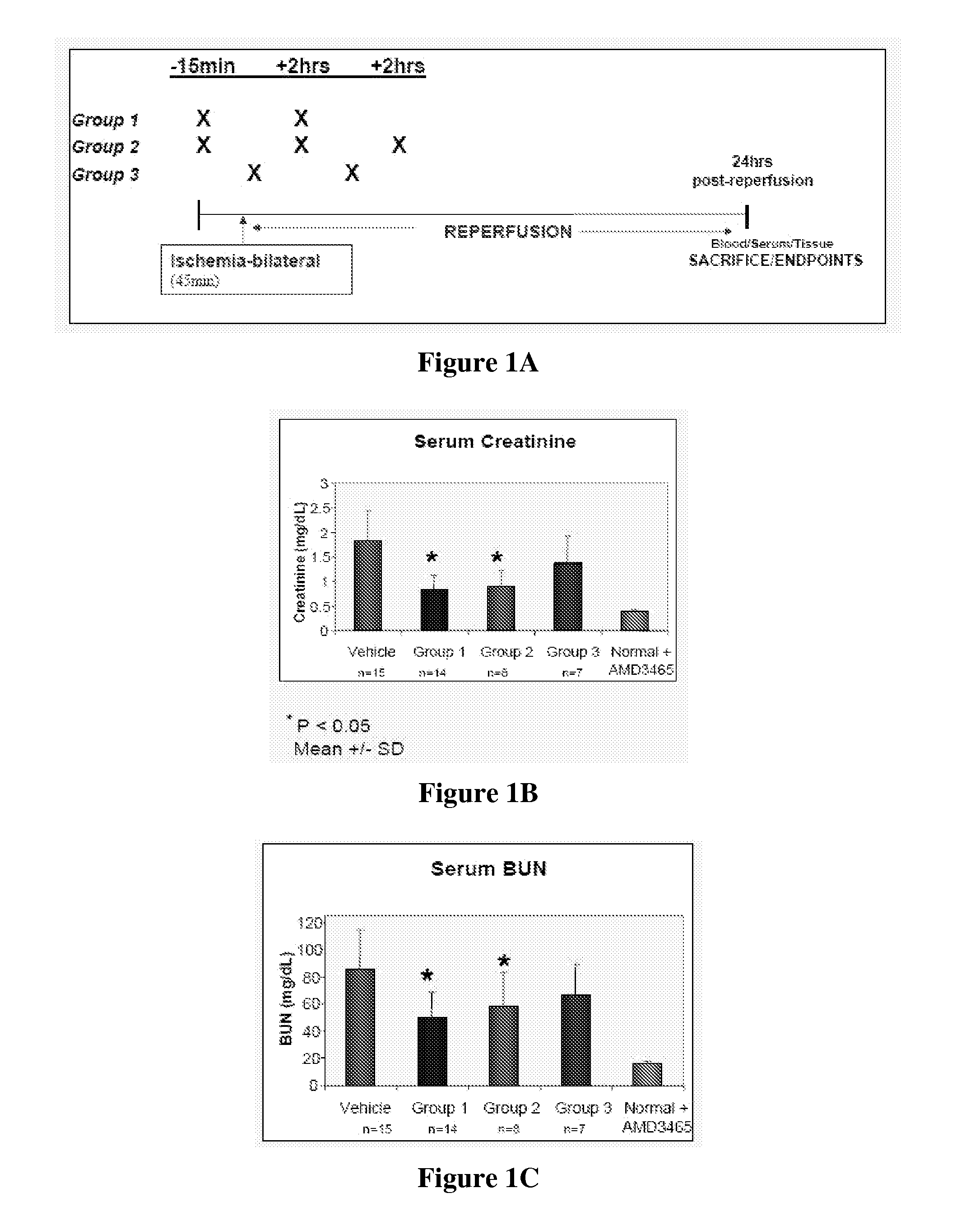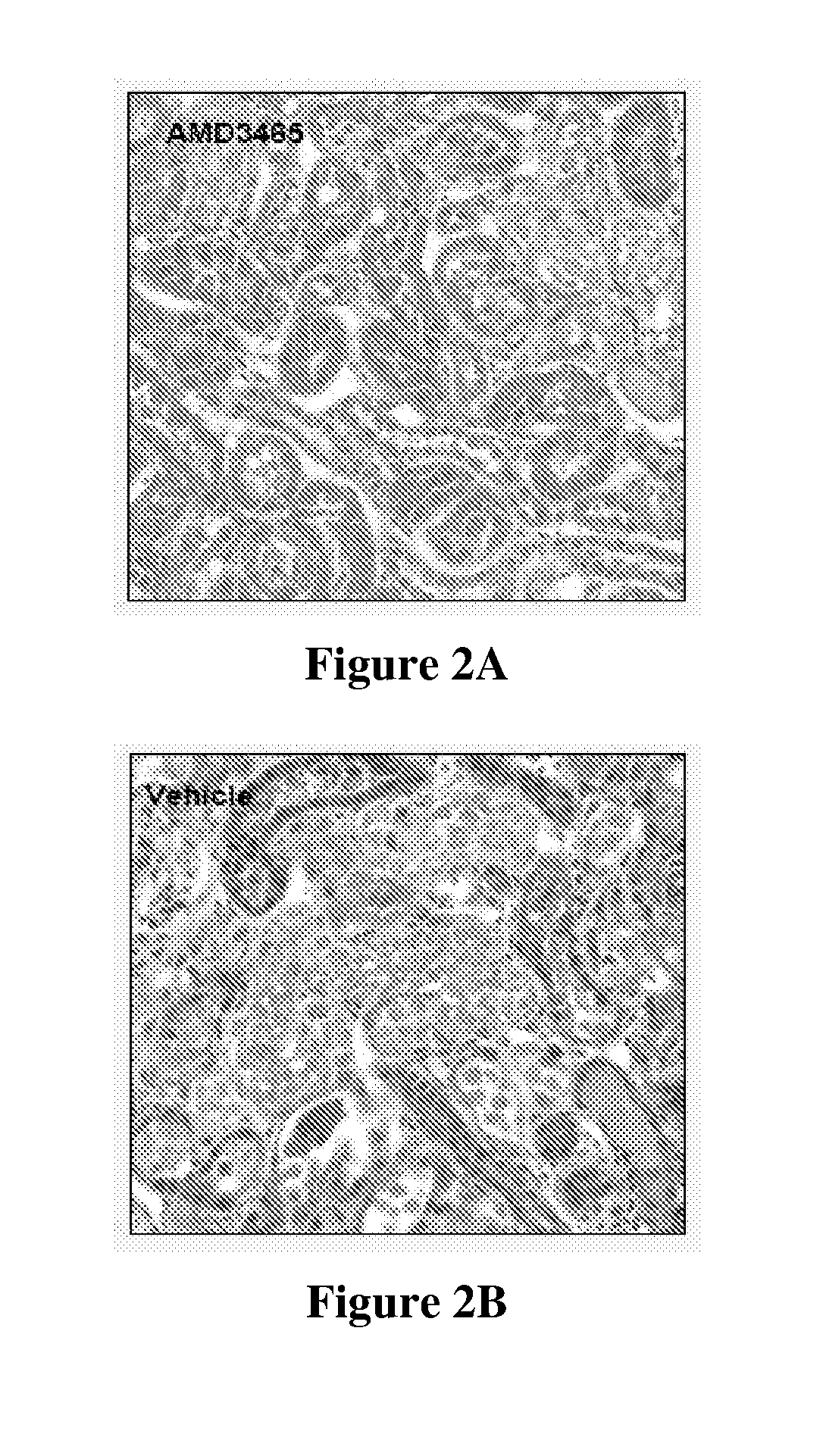Cxcr4 antagonists for kidney injury
a technology of antagonists and kidneys, applied in the field of therapeutics and medicinal chemistry, can solve the problems of kidney failure to excrete nitrogenous waste, loss of urine concentration ability, and inability to maintain fluid and electrolyte balance, and achieve the effect of reducing the risk of allograft rejection
- Summary
- Abstract
- Description
- Claims
- Application Information
AI Technical Summary
Benefits of technology
Problems solved by technology
Method used
Image
Examples
example 1
Effects In Vivo of Multiple Dosing Strategies of AMD3465
[0840]This example illustrates the effect of multiple dosing strategies of AMD3465 in an in vivo rat model of renal ischemia-reperfusion injury in which the renal artery and vein of both kidneys were clamped for 45 minutes followed by removal of the clamps and reperfusion with blood. Dosing AMD3465 at 10 mg / kg, 15 minutes prior to ischemia with another dose 2 hrs later, ameliorated the loss of renal function measured 24 hrs after reperfusion based on levels of serum creatine and serum blood urea nitrogen (BUN). Group 1 follows this dosing regimen as illustrated in FIG. 1A. FIGS. 1B and 1C show creatinine and BUN levels in mg / dL of Group 1 subjects compared to subjects following different dosing strategies shown in FIG. 1A using 10 mg / kg. Also shown in FIG. 1A—Group 2 was dosed at −15 min and +2 hrs and +4 hrs and Group 3 at time 0 and +2 hrs. Subjects administered with the vehicle that had undergone renal ischemia-reperfusion i...
example 2
Histological Effects
[0843]This example provides data showing that AMD3465 maintains structural integrity of the kidney. Rats were dosed as described for Group 1 rats in FIG. 1A. FIG. 2A represents a five micron histological section of kidney tissue from the 24 hr post-reperfusion timepoint stained with hematoxylin / eosin from a subject treated with AMD3465 that had undergone renal ischemia-reperfusion injury; FIG. 2B is an image of kidney tissue of a subject treated with the vehicle with renal ischemia-reperfusion injury. FIGS. 2C and 2D show graphs of the Injury and TUNEL score, respectively. Injury was evaluated by scoring hematoxylin and eosin stained kidney sections on a scale of 1 to 4 for proteinaceous cast formation, cell exfoliation, vascular congestion and loss of tubular architecture. TUNEL staining was carried out on kidney sections to identify apoptotic cells that were then quantified by Metamorph analysis. Comparisons between subjects treated with AMD3465 and subjects th...
example 3
Effect on Microvascular Permeability
[0844]This example provides data that shows AMD3465 reduced microvascular permeability. Leakage of plasma proteins and secretion of von Willebrand Factor (vWF) are two indicators of the loss of microvascular integrity. FIGS. 3A and 3B are images of kidney tissue harvested 24 hrs after renal ischemia-reperfusion from subjects treated with the vehicle and AMD3465, respectively; tissue sections were immunostained with an antibody that recognizes rat immunoglobulin (IgG) and immunoreactivity quantified by Metamorph analysis illustrated in FIG. 3C. FIG. 3C shows the change of rat IgG count in subjects that had undergone renal ischemia-reperfusion injury and were administered either AMD3465 or vehicle, or normal subjects that received AMD3465. FIG. 3D shows the difference of vWF measured in the serum by ELISA from subjects that had undergone renal ischemia-reperfusion and were administered either AMD3465 or vehicle, or normal subjects that were administ...
PUM
| Property | Measurement | Unit |
|---|---|---|
| Force | aaaaa | aaaaa |
| Electric charge | aaaaa | aaaaa |
| Body weight | aaaaa | aaaaa |
Abstract
Description
Claims
Application Information
 Login to View More
Login to View More - R&D
- Intellectual Property
- Life Sciences
- Materials
- Tech Scout
- Unparalleled Data Quality
- Higher Quality Content
- 60% Fewer Hallucinations
Browse by: Latest US Patents, China's latest patents, Technical Efficacy Thesaurus, Application Domain, Technology Topic, Popular Technical Reports.
© 2025 PatSnap. All rights reserved.Legal|Privacy policy|Modern Slavery Act Transparency Statement|Sitemap|About US| Contact US: help@patsnap.com



